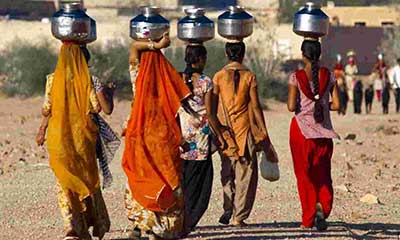Date: 02/05/2023
Relevance: GS-1: Role of women and women’s organization, population and associated issues, poverty and developmental issues, urbanization, their problems and their remedies.
Relevance: GS-3: Conservation, environmental pollution and degradation, environmental impact assessment.
Key Phrases: warming of the planet, rising sea levels, droughts, gender-based violence, societal norms and gender roles, Women’s Environment and Developmental Organisation.
Context:
- The climate crisis manifesting itself in the form of the warming of the planet, rising sea levels, droughts, and extreme temperatures have in fact, today, increased the frequency and severity of natural disasters, heightening the sufferings of millions of people.
- Marginalised groups such as racial and ethnic minorities, and those belonging to lower socioeconomic backgrounds, however, experience the effects of climate change more intensely.
- Of the marginalised groupings, it is the women who experience the most detrimental as well as disproportionate effects of climate change. In comparison to men, it is predominantly women who are more likely to live in poverty, have limited access to civil rights and democratic freedom, and are confronted with systemic violence that often escalates during periods of instability.
Factors responsible for a disproportionate effect on women:
- Limited access to resources: Women often have limited access to resources such as land, credit, and technology, which can make it difficult for them to adapt to the impacts of climate change.
- Unequal distribution of labour: Women are often responsible for
household tasks such as cooking, cleaning, and collecting water and
firewood. Climate change can exacerbate these tasks by making it more
difficult to access these resources, increasing women's workload, and
limiting their ability to engage in other activities such as education or
income-generating activities.
- For instance, when natural disasters like heat, droughts, and extreme temperatures dry up sources of water, affecting the availability of natural water, women and girls are forced to travel for miles and miles in search of water for cooking, bathing, cleaning, etc. As a result of which, they are left with little time to pursue self-rejuvenation activities and other household chores.
- Gender-based violence: Women are at greater risk of gender-based violence in the aftermath of natural disasters and climate-related events. This can further limit their mobility and ability to access resources and services.
- Limited participation in decision-making: Women are often underrepresented in decision-making processes related to climate change, limiting their ability to influence policy and programming that affect them.
- Societal norms and gender roles: Societal norms and gender roles can reinforce inequalities, limiting women's access to education, healthcare, and other resources. This can make it more difficult for them to adapt to the impacts of climate change and exacerbate existing vulnerabilities.

Impacts on women:
- Climate change can have significant and often disproportionate impacts
on women, particularly those living in developing countries or marginalized
communities.
- Disproportionate impact: Women are more likely to experience the negative impacts of climate change due to social and cultural norms. Women often have limited access to education, health care, and employment opportunities, which can exacerbate the effects of climate change on their well-being.
- Water scarcity: Climate change is causing changes in rainfall patterns, leading to droughts, floods, and water scarcity. Women, who are often responsible for collecting water for their households, are forced to walk longer distances to fetch water, increasing their workload and putting them at risk of physical harm.
- Food insecurity: Changes in weather patterns are affecting agricultural production, making it more difficult for communities to grow and access food. Women are often the primary food providers for their families and are therefore more vulnerable to food insecurity caused by climate change.
- Health impacts: Climate change can lead to an increase in vector-borne diseases such as malaria, dengue, and Zika, which can have a disproportionate impact on women and children. Women are also more likely to suffer from malnutrition, anaemia, and other health conditions due to the impacts of climate change on food security and water availability. Anecdotal evidence has, in fact, established a direct relation between extreme heat and increased chances of stillbirth.
- Displacement: Climate change is causing more frequent and severe natural disasters, such as floods, droughts, and hurricanes, which can force communities to flee their homes. Women are often at greater risk of displacement due to their social and economic vulnerabilities.
- According to the United Nations (UN), 80 percent of those already displaced by climate change and the consequent crisis globally are women.
Conclusion:
- However, despite their vulnerability and repeated marginalisation, women shouldn’t merely be viewed as victims of the climate crisis. They instead need to be appreciated as active and effective individuals that possess the innate ability to implement, design, as well as promote climate adaptation and mitigation approaches that could considerably help in coping with calamities.
- Women have historically developed knowledge and skills related to natural resource management including food preservation and rationing, water harvesting and storage, etc. For instance, in Africa, women often embody wisdom pools with traditional expertise and inherited local knowledge that revolves around understanding early warning signs and the effective mitigation of short as well as long-term impacts of disasters. Besides, women across the globe have also been leading climate action movements and providing a hand in developing alternative community models that focus on sustainability, conservation, as well as cooperation.
- It is essential to address these underlying factors and promote gender equality when developing policies and strategies to address climate change. This will help ensure that women are not disproportionately affected by the impacts of climate change and can contribute to climate action on an equal footing with men. It is essential to consider gender-specific impacts when developing policies and strategies to address climate change.
Source: ORF-Online
Mains Question:
Of the marginalised groupings, it is the women who experience the most detrimental as well as disproportionate effects of climate change.Discuss (150 Words).







